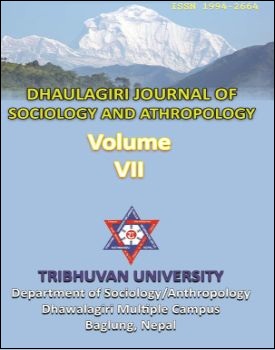Development and Environment: An Assessment of Population Growth vis-a-vis Soil Erosion in Nepal
DOI:
https://doi.org/10.3126/dsaj.v7i0.10442Keywords:
Myths and Narratives, Environment, Soil Erosion, Population Growth, Himalaya, NepalAbstract
This paper discusses the environmental myths and narratives prevailing in Nepal in reference to the population growth and soil erosion. Soil erosion is taken as primary element of environmental degradation by the theory of the Himalayan Environmental Degradation (HED). Many myths and narratives were generated by the vested interest groups to develop the HED. Population growth and over exploitation of natural resource were considered as the prominent causes of soil erosion related environmental degradation. The myths and narratives based on the theory of the HED are still influential in development and environmental policy process in Nepal. In this background this paper highlights some of the research findings that are contrary to conventional belief i.e. population growth lead to soil erosion. The paper is based on literature review. The research evidences from both social and natural sciences are entertained. This paper generates alternative thinking to end the hegemony and unquestionable acceptance of the findings of research undertaken by 'Western, White men' as truth; and their recommendations as the 'blue print' solutions. Critics over orthodox environmentalism and neo-Malthusian accounts are made to validate the ‘hybrid knowledge’ generated in this paper. There are evidences that population pressure have promoted soil erosion. However, Himalayan environmental dynamism which is purely a natural process is far more responsible for soil erosion in the Himalaya. Hence, it is suggested that a critical assessment of any ‘facts’ obtained from research should be made before making them the narratives and reflecting them in policy process.
DOI: http://dx.doi.org/10.3126/dsaj.v7i0.10442
Dhaulagiri Journal of Sociology and Anthropology Vol. 7, 2013; 173-196




